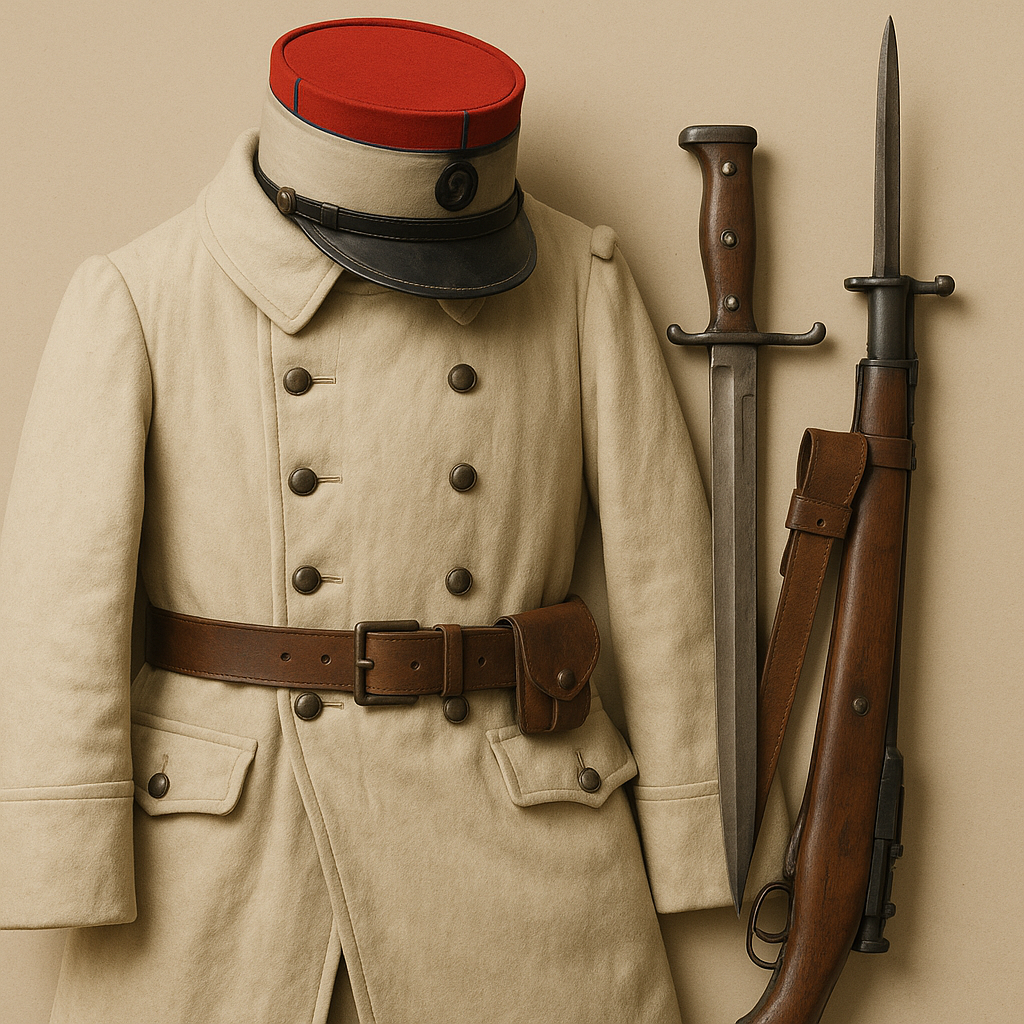
WW1 French Uniform Parts: A Deep Dive into the Iconic Gear of the Great War
Published on May 03, 2025
WW1 French Uniform Parts: A Deep Dive into the Iconic Gear of the Great War
When imagining a World War I battlefield, the image of a French soldier often comes to mind—clad in a deep blue greatcoat, topped with a distinct kepi hat, and armed with a bayonet-ready rifle. French WW1 uniform parts were not only practical for warfare but also symbolic of the nation's military heritage. In this article, we’ll explore these fascinating pieces, from the famous French WW1 greatcoat to the WWI French bayonet and the headwear that distinguished the fierce fighters of the French Foreign Legion.
1. The French WW1 Greatcoat: Style Meets Battlefield Function
One of the most defining items of the WW1 French uniform is the greatcoat, known as the capote. This coat became a staple on the Western Front due to its durability and protection against the cold and wet trenches of Europe.
Design & Material
The traditional French WW1 greatcoat was constructed from heavy wool dyed in the famous horizon blue to replace the more visible dark blue and red colours used before 1915. It featured:
- A double-breasted front for added insulation
- High collars for wind protection
- Epaulettes and rank insignias stitched onto the shoulders
- Large pockets and a rear split for ease of movement
This coat not only served a practical purpose but also became a lasting image of French resilience during the war.
Why Collectors Love It
Due to its historical value and rugged aesthetic, the French greatcoat is highly sought after by reenactors and collectors. At Paddelaters.com, we ensure each piece—whether original or reproduction—retains the authenticity that connects wearers to history.
2. French Bayonet WW1: The Soldier’s Close-Combat Companion
Equally important to the French soldier’s arsenal was the WWI French bayonet. Attached to the end of the Lebel or Berthier rifle, this blade turned a firearm into a fearsome melee weapon.
Historical Overview
Among the most well-known models was the Épée-Baïonnette Modèle 1886, or “Rosalie,” as many soldiers affectionately called it. Key features included:
- A cruciform blade design, ideal for piercing enemy uniforms and gear
- A lightweight frame that didn't hinder rifle operation
- A brass or steel handle, depending on the production year
The French bayonet in WW1 wasn’t just a weapon—it became a symbol of French grit in the close quarters of trench warfare.
Why It Matters Today
Collectors and militaria enthusiasts prize these bayonets not only for their craftsmanship but for the stories they carry. Whether original or expertly reproduced, they reflect a powerful era of history preserved at Paddelaters.
3. The Kepi French Foreign Legion: A Hat Worn with Honor
When discussing WW1 French uniform parts, one cannot overlook the iconic kepi, especially the version worn by the French Foreign Legion. Known for their fierce loyalty and bravery, the Legionnaires' distinctive headgear carried deep cultural significance.
French Foreign Legion Hat Name
The formal name of this famous hat is simply kepi. Derived from the German word Käppi, it was adopted by French military forces in the 19th century and became a standard issue.
Design Features
The Legion’s kepi was characterized by:
- A flat circular top with a stiff brim
- Often adorned with regimental insignia or colours
- Constructed from durable wool and leather
During WW1, many kepis were covered with blue or khaki cloth to reduce visibility, but their shape remained unmistakable.
A Symbol of Identity
To the French Foreign Legion, the kepi wasn’t just a hat—it was an emblem of their elite status. Today, it continues to inspire respect among military historians and uniform collectors.
4. Why WW1 French Uniforms Remain Iconic
French WW1 uniforms were among the first to undergo radical redesigns to meet the challenges of modern warfare. Beyond their functionality, they represent:
- Evolution of battlefield strategy – from bright colours to camouflage tones
- Cultural symbolism – such as the kepi's representation of honour
- Human resilience – enduring harsh environments and trench conditions
5. Reenactment, Collecting, and Preservation
At Paddelaters.com, we understand that owning a piece of WWI history is about more than just aesthetics. It’s about preserving a story. That’s why we offer:
- Authentic reproductions of WW1 French uniform parts
- Accurate historical details in every garment and weapon replica
- Support for reenactors who bring history to life on the field
Whether you're a military collector, museum curator, or historical reenactor, our catalogue honours the heritage of these remarkable uniforms.
Conclusion: Step Into History With Every Stitch
WW1 French uniform parts—from the battle-tested greatcoat to the gleaming bayonet and the ever-iconic kepi—are more than just clothing or accessories. They are tangible links to the past, each with its tale of courage, duty, and endurance.
